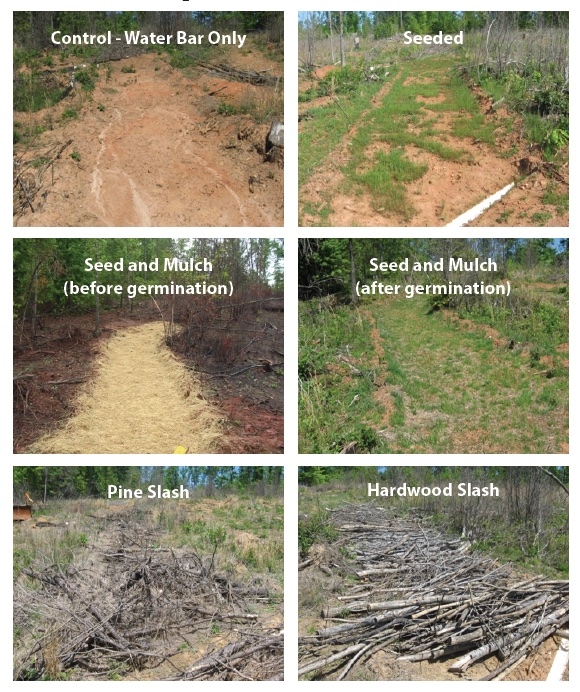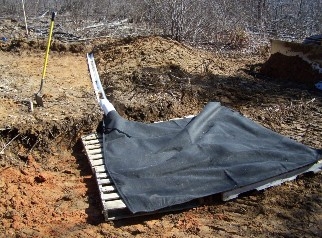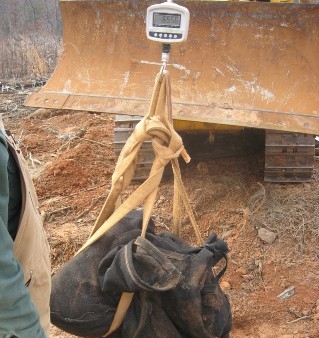Effectiveness of Skid Trail Closure Techniques. Forest Operations Research Highlights
ID
ANR-109NP
Implementing Best Management Practices (BMPs) on Forest Harvesting Operations
Protection of water quality is a critical component of forest harvesting operations. Virginia’s silvicultural water quality law (§10.1-1181.1 through 10.1-1181.7) prohibits excessive sedimentation of streams as a result of silvicultural operations. Virginia’s logging businesses invest substantial resources implementing BMPs to protect water quality. The Virginia Depart- ment of Forestry (VDOF) is responsible for enforcing this law and inspects all logging operations to ensure protection of water quality. BMP guidelines offer mul- tiple possible options for practices to minimize erosion and sedimentation and protect water quality. Select- ing the most appropriate BMP will depend on specific site conditions, as well as resources available on-site for implementing BMPs. However, research results on BMP implementation can help guide decisions related to BMP implementation for protecting water quality.

Temporary Skid Trail Closure Options
This research focused on evaluating post-harvest ero- sion from skid trails with different closure methods. Both bladed skid trails and overland skid trails were evaluated using the same methods on similar sites. Researchers measured erosion from five different options for skid trail closure. The control treatment used water bars only. On the rest of the treatments, in addition to water bars, treatments evaluated the impacts of grass seed only, grass seed and mulch, hard- wood slash, and pine slash.

Evaluating Skid Trail Closure Options
Two sites on the Reynolds Homestead Forest Resources Research Center in Patrick County were used for these evaluations. One site evaluated bladed skid trails while the other evaluated overland skid trail closure methods. A designed experiment was used to replicate each of the five treatments. Runoff from each segment of the skid trail was funneled into a sediment filtering “dirt bag” that allowed collection of all sediment leaving the trail. The dirt bags were weighed and emptied monthly for one year.


Results
Bladed Skid Trails
The control treatment for bladed skid trails (water bars only) resulted in a relatively high erosion rate of 61.2 tons per acre per year. Simply seeding the trails reduced erosion by 77 percent to 14 tons per acre per year. Applying slash (hardwood or pine) or grass seed and mulch all reduced erosion rates by over 90 percent compared to water bars alone.
Treatment |
Actual Erosion T/A/Y* |
Erosion Reduction (%) |
Control (water bar only) |
61.2 |
- |
Grass Seed |
14 |
77 |
Hardwood Slash |
3.9 |
94 |
Pine Slash |
2.6 |
96 |
Grass Seed and Mulch |
1.3 |
98 |
Table 1. Erosion rates by treatment for bladed skid trails.
Overland Skidding
Overland skidding in general had lower erosion rates than bladed skid trails because some of the original cover such as roots, stumps, and leaf litter remained on the trail. Seeding the skid trails resulted in a 44 percent decrease in erosion to 6.1 tons per acre per year. Apply- ing slash (hardwood or pine) or grass seed and mulch reduced erosion rates by over 70 percent compared to water bars alone.
Treatment |
Actual Erosion T/A/Y* |
Erosion Reduction (%) |
Control (water bar only) |
10.8 |
- |
Grass Seed |
6.1 |
44 |
Hardwood Slash |
2.3 |
79 |
Pine Slash |
2.4 |
78 |
Grass Seed and Mulch |
1.5 |
86 |
Table 2. Erosion rates by treatment for overland skid trails.

A comparison of bladed and overland trails highlights the difference in erosion and shows the reduction in erosion for each treatment.
Conclusions and Recommendations
Overland skid trails produced less erosion than bladed skid trails because they retained more ground cover. Even though slopes were steeper on overland skid trails they produced approximately 82 percent less erosion than the bladed skid trails. All of the treatments pro- vided significant reductions in erosion compared to the control of water bars only. Seeding alone can reduce erosion rates, but is much more effective when mulch is utilized to enhance grass establishment and to provide cover until the vegetation is established.
Grass seed and mulch was a very effective closure method although in many cases it may be a more expensive option. Both pine and hardwood slash treat- ments were effective at preventing erosion. When slash is placed on skid trails during the harvesting operation, this is likely one of the most cost-effective methods of preventing erosion and provides immediate ground cover. Using slash to stabilize skid trails would be appropriate for trails that are intended for permanent closure and would not be used where future access would be needed.
For Additional Information on BMP Implementation:
The Virginia Department of Forestry (www.dof.virginia.gov) is responsible for inspecting logging opera-tions in Virginia. All commercial timber harvests are inspected for compliance with the Silvicultural Water Quality Law. The VDOF’s complete handbook for BMPs for water quality is available online at http://www.dof.virginia.gov/water/index-BMP-Guide.htm.
For specific questions relating to implementation of BMPs on harvest sites, please contact your local VDOF personnel. A list of VDOF personnel can be found online at http://www.dof.virginia.gov/abou-tus/contact-us.htm or by calling their central office at 434-977-6555.
Additional information can be found in the following publications:
SaLwaykeerlsI,IIB. .C20.,12M. .“CE.ffBeocltdivinenge, sWs .aMnd. Aimusptl,emanedntWati.oAn. costs of overland skidding closure techniques in the Virginia Piedmont.” Journal of Soil and Water Conservation, 67(4):300-310.
Wade, C.R., M.C. Bolding, W.M. Aust, and W.A. Lakel III. 2012. “Comparison of five erosion control techniques for bladed skid trails in Virginia.” Southern Journal of Applied Forestry, 36(4):191-197.
This publication was funded, in part, with an integrated, internal competitive grant from Virginia Agricultural Experiment Station, Virginia Cooperative Extension, and the College of Agriculture and Life Sciences at Virginia Tech.
Virginia Cooperative Extension materials are available for public use, reprint, or citation without further permission, provided the use includes credit to the author and to Virginia Cooperative Extension, Virginia Tech, and Virginia State University.
Virginia Cooperative Extension is a partnership of Virginia Tech, Virginia State University, the U.S. Department of Agriculture, and local governments. Its programs and employment are open to all, regardless of age, color, disability, sex (including pregnancy), gender, gender identity, gender expression, genetic information, ethnicity or national origin, political affiliation, race, religion, sexual orientation, or military status, or any other basis protected by law.
Publication Date
December 13, 2019



